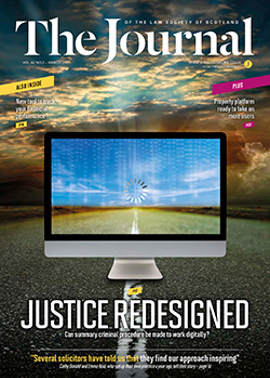Defence submissions

Unlike the two previous papers produced through the Evidence and Procedure Review, A New Model for Summary Criminal Court Procedure was delivered by a working group with members from across the criminal justice system. Police, COPFS, sheriffs, sheriff clerks, Scottish Courts & Tribunals Service, Government and SLAB were all represented – and were joined by two defence solicitors, Peter Lockhart, a veteran of 38 years’ practice in Ayr, and Glasgow solicitor advocate James Mulgrew. Both sit on the Law Society of Scotland’s Criminal Law Committee, but took part in the working group in a personal capacity and without a party line.
Meeting between August and December 2016, the group was given a clear instruction by the Lord Justice General at the outset not to “tinker” with the system but to “start with a blank sheet”, and devise something fit for the 21st century, Lockhart relates. The outcome is a model that looks radically different from the present one, pretty much from the point of arrest onwards.
A fundamental question at the outset was how to get an accused, if released from custody, to engage with the process. If it requires providing a mobile number or email address, how many people remember these, especially in a state of intoxication late at night? This is something that “needs further development”, Lockhart comments.
Case flows
Assuming that can be overcome, the paper sets out various case flows depending on whether the accused is in custody, and the nature of the plea to be tendered. An accused released following charge would be given a coded ticket with which their solicitor, on being consulted, could log into the system to check when and where their client was charged, and confirm they are acting. This would trigger service of the complaint, which might well be electronically. A plea would be tendered, and perhaps negotiated, online; if agreement is reached, the sheriff would consider a written statement in mitigation and decide whether to sentence also online or call for a personal appearance, if necessary after instructing reports through the same system.
If the plea is not guilty, or agreement cannot be reached, the case management system “comes to the fore”, Lockhart says. Crown evidence would be disclosed from the digital archive and the sheriff would seek to ascertain what was agreed and what issues would have to go to trial. But the defence would not be able just to say that their instructions were not to agree the evidence – a point already established for solemn procedure by Ashif and Ashraf v HM Advocate [2015] HCJAC 100. Only after that process will the system fix a trial diet and cite witnesses, taking account of information as to dates when the various players will not be available.
Streamlined procedures with reduced timescales would apply to those in custody or released on undertakings.
A rare point of difference within the working group emerges at the paper’s discussion regarding agreement of evidence. Two options are set out, the first requiring the defence to make an initial assessment of the Crown witness list and identify which witnesses it views as uncontroversial; the second requiring the Crown to carry out its own assessment before issuing the witness list. Lockhart and Mulgrew have been holding out for the second option as in line with the onus on the Crown to prove its case.
Cut the dead time
To illustrate the benefits the new system would bring, Lockhart instances a case of his, where a client with an analogous record was charged with drug offences. Following Crown disclosure she changed her plea to guilty; at the intermediate diet the sheriff called for reports and deferred sentence. Time engaged on the day totalled five hours, including return travel from Ayr to Kilmarnock and waiting for the case to call.
Under the new system, the change of plea would be intimated online, along with the plea in mitigation; the Crown narrative and previous convictions would be provided electronically; reports would be instructed in the same manner, and then provided to the solicitor, who could amend the plea in mitigation if necessary; and the sheriff would decide whether to sentence online or require a personal appearance.
Legal aid: any downside?
What will it all mean in terms of legal aid payments? Here Lockhart is cautiously optimistic. SLAB appeared to view the proposals positively, even while recognising that the new system would be likely to result in an increase in legal aid spending. This would be offset by savings elsewhere in the justice system.
“There was no suggestion that this would result in any reduction of the fixed fee,” Lockhart affirms. “By dint of the fact that we will have to be more proactive in managing our cases towards the trial diet, and in trying to agree evidence, because the Crown are going to send us information they think is capable of agreement and we will have to sit down and consider that, particularly if there will be shrieval involvement, our argument was that we will be doing a lot of work and if you want this to work, it’s important that solicitors will be remunerated fairly and properly for their input.”
While budget controllers are not always known for taking such a broader view of spending and savings, he points to the High Court procedure reforms, in relation to which Lord Bonomy, their sponsor, made it clear that they were predicated on defence lawyers engaging with them and receiving proper remuneration for doing so.
Also impacting on legal aid spending is the likelihood that the new system will militate against accused persons representing themselves: while it will provide for the unrepresented accused, they are likely to find it more difficult to conduct their own case.
Remaining concerns
What concerns remain regarding the proposals? For Lockhart, the main one on which further work is required is how to encourage and ensure the participation of the accused from the early stages of a case. Whatever system is adopted will have to catch up people with chaotic lifestyles.
Beyond that, since sheriffs involved in case management will have access to the evidence in the case, there should be an insistence that a different sheriff takes over for the trial and sentencing stages.
It is also conceivable that, as now happens with prosecution case marking, digital case management could result in “hubs” developing where sheriffs spend their time managing cases from different parts of the country. Lockhart, who describes the scenario as the working group’s “elephant in the room”, cautions that if it were to happen, trial and sentencing stages should continue to be taken at local level.
His final concern is for the next generation of court lawyers, and their prospects for honing their skills. The number of trials that take place (as opposed to the number of trial diets fixed) probably will not change much after the reforms, but “However you look at it, we will be spending less time in court. Pleas and continuations are often where court lawyers start their learning curve: you don’t put someone straight on to a summary trial once they are entitled to appear in court.” But he accepts that that consideration is not going to impede the reforms if they are otherwise felt desirable.
Lockhart concludes by urging the profession to involve itself, as of now, with the process of replacing the present “pretty disorganised” system with a streamlined one fit for the digital age. A long journey still lies ahead, and the outcome may not even be achieved in his working life. “But it’s essential that the profession now engages in debate. I would like to think that we can leave a legacy for the next generation that is much more efficient, streamlined and user friendly for all members of the criminal justice system, not just solicitors.”
Society reaction
Following publication of the New Model report, Eilidh Wiseman, President of the Law Society of Scotland, said: “There is much to welcome in SCTS’s proposals for summary court reform and we applaud the innovative approach taken. The paper makes some radical proposals which would potentially change the face of summary court practice if implemented.
“Greater use of technology could bring substantial improvement to our courts. However, if we are to adopt more technology-driven processes, they will need to be properly resourced. We also need to be aware that not everyone has access to the internet and it will be essential that accused people, particularly those who are vulnerable, fully understand any new system to ensure their rights are upheld.
“A key area of focus for us is around the proposals for defence solicitors, who would be expected to take a more active role in the pre-trial management of criminal cases. Such a model raises some challenging and practical issues for defence solicitors in making sure they continue to meet their professional obligations of working in the best interests of their client, and would also have implications for legal aid – which has been recognised in the paper.
“Moving towards a digital future for summary justice is the clear direction of travel, and the review paper provides an important opportunity to look at how we can we work towards improving our criminal justice system. We will be engaging in SCTS’s series of public consultation events this spring, to explore in depth the changes that would be necessary and the challenges to be overcome in delivering this new model, and we encourage our members to do likewise.”
In this issue
- Ineligibility – an open and shut case?
- Rent deposits – filling in the gaps
- EU at the crossroads
- Brexit: the human rights dimension
- Reading for pleasure
- Opinion: Andrew Lothian
- Book reviews
- Profile
- President's column
- Digital consultation closes
- People on the move
- Clear sky over summary courts
- Defence submissions
- Bookmark the benchmark
- GDPR: Practical steps for Scottish law firms to prepare
- Heads for business
- Spousal visas and the income rule
- Compete or get beat
- Platform party
- The consequences of excluding consequential loss
- Understanding the other side's position
- Family complexities
- Unitary patent: sunrise or sunset for UK holders?
- Third option
- Land reform, step by step
- Member against member?
- Scottish Solicitors' Discipline Tribunal
- Power of attorney update
- The 2012 Act: a bold step forward?
- Back to university
- Accreditation: calling regulatory lawyers
- Law reform roundup
- Street Law shows the way
- Year of big news
- De-risking email
- Paralegal pointers
- Ask Ash
- Top of the list
- Just your luck?
- Executries and pension overpayments






